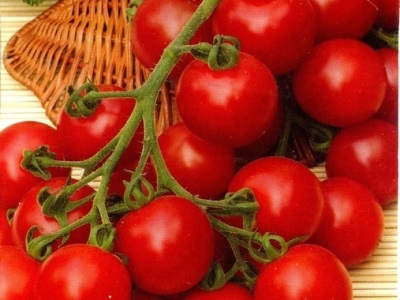
- Authors: Japan
- Year of approval: 2009
- Name synonyms: Cherry Blossom, Cherry Blossom
- Category: hybrid
- Growth type: determinant
- Appointment: universal
- Ripening period: mid-early
- Ripening time, days: up to 110
- Growing conditions: for open ground, for film greenhouses
- Marketable fruit yield,%: 95
Cherry tomatoes are becoming more and more popular among summer residents and farmers. Unpretentious and productive species are especially in demand. These include the mid-early Cherry Blosem tomato.
Breeding history
Cherry Blosem is a striking representative of the Japanese selection, bred in 2008 by scientists from the Sakata agricultural company. The nightshade crop was included in the State Register of approved for use on the territory of the Russian Federation in 2009. Recommended for growing hybrid tomato in all climatic zones of the country. The hybrid grows and gives good yields both in the beds and in greenhouse conditions.
Description of the variety
Cherry Blosem tomato is a low-growing determinant plant, stretching up to 110 cm in height. The bushes are characterized by moderate foliage with green foliage, thin and fragile stems, a developed root system and complex inflorescences. The first fruit cluster is laid above 5-7 leaves. Mini-tomatoes are attached to the fruit branch with a stalk with an articulation. On average, about 20 berries are tied in each fruit cluster.
Growing cherry tomatoes, you will need the formation of bushes in 3 stems, mandatory garters to reliable supports, as well as the timely removal of unnecessary stepsons. Thinning of foliage at the bottom of the bushes is optional. Cherry Blosem tomatoes are universal, therefore they are used in cooking, eaten fresh, canned whole, processed into juices and dressings, and also pickled.
The main qualities of the fruit
Cherry Blosem belongs to the category of small-fruited nightshades. The average weight of a berry is 20-25 grams, and sometimes 30 grams. The shape of the vegetable is correct - round with a perfectly smooth surface. Ripe tomatoes are evenly covered with a rich red color, and in a state of incomplete ripeness they are green, with darkening at the stalk. The peel of mini tomatoes is dense with a gloss, but when eaten it seems incredibly thin. Tomatoes are characterized by excellent resistance to cracking, good transportability and long-term keeping quality - up to 30 days in a cool place.
Taste characteristics
Despite the hybridity, the vegetable's taste is excellent. The pulp of a tomato is fleshy, dense and very juicy, with a small amount of seeds. The taste is dominated by pronounced sweetness, complemented by a light dessert aroma. The pulp contains about 3% sugars and up to 6% dry components.
Ripening and fruiting
Cherry Blosem belongs to the early maturing species. Less than 110 days pass from the moment of mass appearance of sprouts to ripe mini-berries on the hands. Vegetables are spiced together, so the harvest can be removed with whole brushes. You can taste tomatoes in the first half of July. The phase of active fruiting occurs in July-August.
Yield
Observing all agrotechnical recommendations, you can grow and collect from 3.7 to 4.5 kg of tomatoes per 1 m2. As a rule, 1 bush gives 1-1.2 kg of tomatoes per season.
The timing of planting seedlings and planting in the ground
Tomatoes are grown mainly through seedlings.Sowing seeds is done in mid-March. For better germination, the boxes with seedlings are covered with glass or polyethylene. Usually, mass germination occurs on the 7th day.
At the stage of the appearance of 3-4 leaves on each plant, a dive is carried out (seating in individual containers). 7-10 days before transplanting, the bushes are hardened, exposing them daily to fresh air. When growing seedlings, do not forget about feeding and watering.
Bushes are transplanted at the age of 50-60 days, when 4-5 leaves have grown on each bush and one flower brush is formed. As a rule, disembarkation takes place in May.

Growing tomato seedlings is an extremely important process, because it largely depends on whether the gardener can harvest at all. All aspects must be taken into account, from seedbed preparation to planting in the ground.
Landing scheme
Correctly planting tomato bushes in the garden is one of the rules for caring for a crop. 3-4 bushes can be planted per 1 m2, which will provide free access of oxygen and light to all plants. The recommended layout for planting is 40x50 cm.

Growing and caring
Tomatoes grow comfortably in fertile, loose, breathable and clean soil with neutral acidity. It is good if the site is illuminated by the sun. It is not recommended to plant tomatoes in beds where potatoes or eggplants were previously grown.
Care includes watering, feeding, shaping, garters and pinching, as well as protection from pests and viruses.




A plant needs different micronutrients at each stage of growth. All fertilizers can be divided into two groups: mineral and organic. Folk remedies are often used: iodine, yeast, bird droppings, eggshells.
It is important to observe the rate and period of feeding. This also applies to folk remedies and organic fertilizers.
Disease and pest resistance
The hybrid is endowed with high resistance to many diseases - verticillosis, fusarium wilting, alternaria, tobacco mosaic virus and brown spot. In addition, the tomato does not become infected with the nematode. Tomato bushes can be protected from late blight by treating them with fungicides.


Resistant to adverse weather conditions
Due to their resistance to stress, tomatoes can easily withstand temperature extremes, drought and heat.

























































































